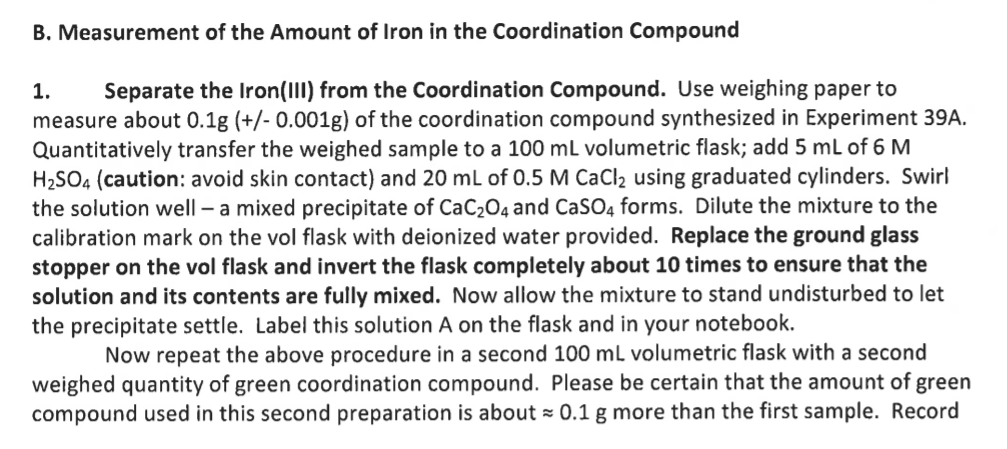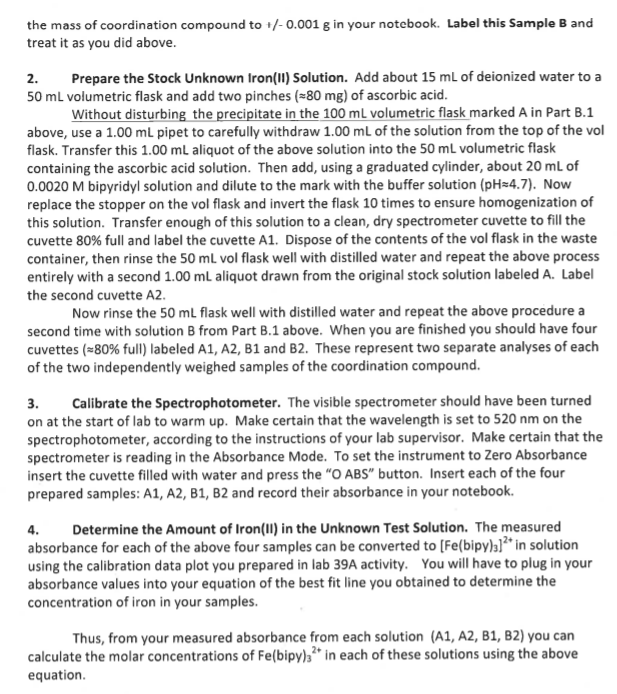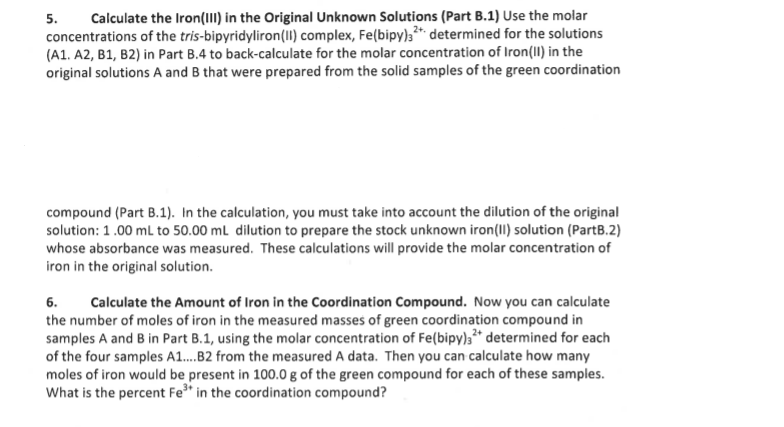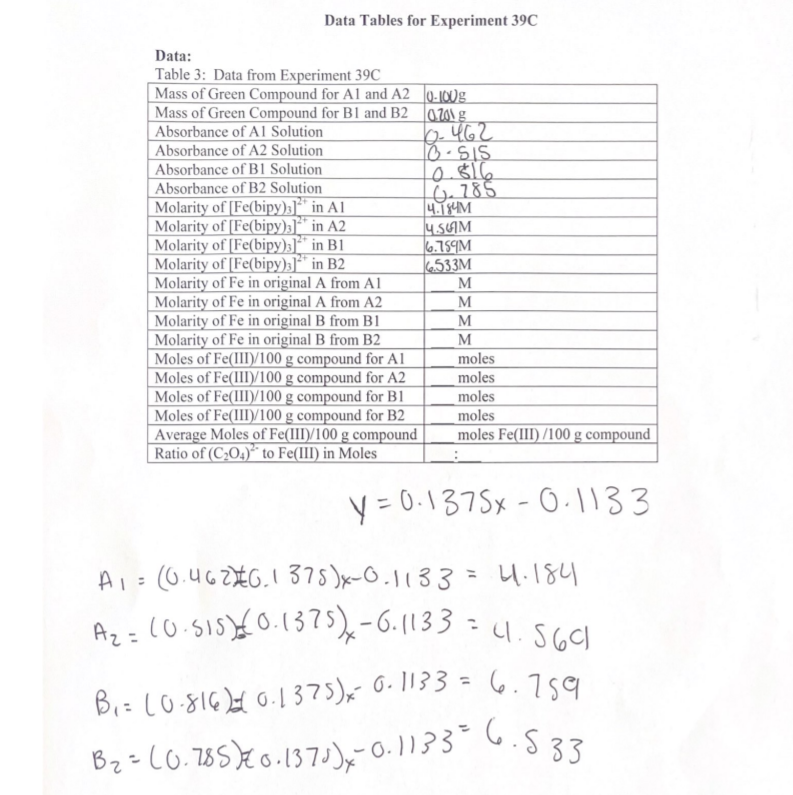



B. Measurement of the Amount of Iron in the Coordination Compound 1. Separate the Iron(III) from the Coordination Compound. Use weighing paper to measure about 0.1g (+/- 0.001g) of the coordination compound synthesized in Experiment 39A. Quantitatively transfer the weighed sample to a 100 mL volumetric flask; add 5 mL of 6 M H2SO4 (caution: avoid skin contact) and 20 mL of 0.5 M CaCl2 using graduated cylinders. Swirl the solution well a mixed precipitate of Cac204 and CaSO4 forms. Dilute the mixture to the calibration mark on the vol flask with deionized water provided. Replace the ground glass stopper on the vol flask and invert the flask completely about 10 times to ensure that the solution and its contents are fully mixed. Now allow the mixture to stand undisturbed to let the precipitate settle. Label this solution A on the flask and in your notebook. Now repeat the above procedure in a second 100 mL volumetric flask with a second weighed quantity of green coordination compound. Please be certain that the amount of green compound used in this second preparation is about = 0.1 g more than the first sample. Record the mass of coordination compound to +/- 0.001 g in your notebook. Label this Sample B and treat it as you did above. 2. Prepare the Stock Unknown Iron(1) Solution. Add about 15 mL of deionized water to a 50 mL volumetric flask and add two pinches (=80mg) of ascorbic acid. Without disturbing the precipitate in the 100 mL volumetric flask marked A in Part B.1 above, use a 1.00 mL pipet to carefully withdraw 1.00 mL of the solution from the top of the vol flask. Transfer this 1.00 mL aliquot of the above solution into the 50 mL volumetric flask containing the ascorbic acid solution. Then add, using a graduated cylinder, about 20 mL of 0.0020 M bipyridyl solution and dilute to the mark with the buffer solution (pH=4.7). Now replace the stopper on the vol flask and invert the flask 10 times to ensure homogenization of this solution. Transfer enough of this solution to a clean, dry spectrometer cuvette to fill the cuvette 80% full and label the cuvette A1. Dispose of the contents of the vol flask in the waste container, then rinse the 50 mL vol flask well with distilled water and repeat the above process entirely with a second 1.00 ml aliquot drawn from the original stock solution labeled A. Label the second cuvette A2. Now rinse the 50 ml flask well with distilled water and repeat the above procedure a second time with solution B from Part B.1 above. When you are finished you should have four cuvettes (+80% full) labeled A1, A2, B1 and B2. These represent two separate analyses of each of the two independently weighed samples of the coordination compound. 3. Calibrate the Spectrophotometer. The visible spectrometer should have been turned on at the start of lab to warm up. Make certain that the wavelength is set to 520 nm on the spectrophotometer, according to the instructions of your la supervisor. Make certain that the spectrometer is reading in the Absorbance Mode. To set the instrument to Zero Absorbance insert the cuvette filled with water and press the "O ABS" button. Insert each of the four prepared samples: A1, A2, B1, B2 and record their absorbance in your notebook. 4. Determine the Amount of Iron(11) in the Unknown Test Solution. The measured absorbance for each of the above four samples can be converted to [Fe(bipy)s]?* in solution using the calibration data plot you prepared in lab 39A activity. You will have to plug in your absorbance values into your equation of the best fit line you obtained to determine the concentration of iron in your samples. Thus, from your measured absorbance from each solution (A1, A2, B1, B2) you can calculate the molar concentrations of Fe(bipy), * in each of these solutions using the above equation. 5. Calculate the Iron(III) in the Original Unknown Solutions (Part B.1) Use the molar concentrations of the tris-bipyridyliron(II) complex, Fe(bipy)324. determined for the solutions (A1, A2, B1, B2) in Part B.4 to back-calculate for the molar concentration of Iron(11) in the original solutions A and B that were prepared from the solid samples of the green coordination compound (Part B.1). In the calculation, you must take into account the dilution of the original solution: 1.00 mL to 50.00 mL dilution to prepare the stock unknown iron(II) solution (PartB.2) whose absorbance was measured. These calculations will provide the molar concentration of iron in the original solution. 6. Calculate the Amount of Iron in the Coordination Compound. Now you can calculate the number of moles of iron in the measured masses of green coordination compound in samples A and B in Part B.1, using the molar concentration of Fe(bipy)=2* determined for each of the four samples A1....B2 from the measured A data. Then you can calculate how many moles of iron would be present in 100.0 g of the green compound for each of these samples. What is the percent Fell in the coordination compound? 6.785 Data Tables for Experiment 39C Data: Table 3: Data from Experiment 39C Mass of Green Compound for Al and A2 0-100g Mass of Green Compound for B1 and B2 0.701 g Absorbance of Al Solution 6.462 Absorbance of A2 Solution 10 - SIS Absorbance of BI Solution 0.$166 Absorbance of B2 Solution Molarity of [Fe(bipy);]** in Al 4.184M Molarity of [Fe(bipy);]*" in A2 4 SUM Molarity of [Fe(bipy);] in B1 6.759M Molarity of [Fe(bipy)]'' in B2 6533M Molarity of Fe in original A from Al M Molarity of Fe in original A from A2 M Molarity of Fe in original B from B1 M Molarity of Fe in original B from B2 M Moles of Fe(III)/100 g compound for Al moles Moles of Fe(III)/100 g compound for A2 moles Moles of Fe(III)/100 g compound for B1 moles Moles of Fe(III)/100 g compound for B2 moles Average Moles of Fe(III)/100 g compound moles Fe(III) /100 g compound Ratio of (C204) * to Fe(III) in Moles V=0.4375X -0.1133 Ai - (0.46236.1 375)x-0.1133 = 4.184 Az -(0.515.0.1375) -6.1133=4.560 B = 10.816 0.1375)x 0.1133 = 6.759 B2=(0.78560.1373)x0.11336.533 + B. Measurement of the Amount of Iron in the Coordination Compound 1. Separate the Iron(III) from the Coordination Compound. Use weighing paper to measure about 0.1g (+/- 0.001g) of the coordination compound synthesized in Experiment 39A. Quantitatively transfer the weighed sample to a 100 mL volumetric flask; add 5 mL of 6 M H2SO4 (caution: avoid skin contact) and 20 mL of 0.5 M CaCl2 using graduated cylinders. Swirl the solution well a mixed precipitate of Cac204 and CaSO4 forms. Dilute the mixture to the calibration mark on the vol flask with deionized water provided. Replace the ground glass stopper on the vol flask and invert the flask completely about 10 times to ensure that the solution and its contents are fully mixed. Now allow the mixture to stand undisturbed to let the precipitate settle. Label this solution A on the flask and in your notebook. Now repeat the above procedure in a second 100 mL volumetric flask with a second weighed quantity of green coordination compound. Please be certain that the amount of green compound used in this second preparation is about = 0.1 g more than the first sample. Record the mass of coordination compound to +/- 0.001 g in your notebook. Label this Sample B and treat it as you did above. 2. Prepare the Stock Unknown Iron(1) Solution. Add about 15 mL of deionized water to a 50 mL volumetric flask and add two pinches (=80mg) of ascorbic acid. Without disturbing the precipitate in the 100 mL volumetric flask marked A in Part B.1 above, use a 1.00 mL pipet to carefully withdraw 1.00 mL of the solution from the top of the vol flask. Transfer this 1.00 mL aliquot of the above solution into the 50 mL volumetric flask containing the ascorbic acid solution. Then add, using a graduated cylinder, about 20 mL of 0.0020 M bipyridyl solution and dilute to the mark with the buffer solution (pH=4.7). Now replace the stopper on the vol flask and invert the flask 10 times to ensure homogenization of this solution. Transfer enough of this solution to a clean, dry spectrometer cuvette to fill the cuvette 80% full and label the cuvette A1. Dispose of the contents of the vol flask in the waste container, then rinse the 50 mL vol flask well with distilled water and repeat the above process entirely with a second 1.00 ml aliquot drawn from the original stock solution labeled A. Label the second cuvette A2. Now rinse the 50 ml flask well with distilled water and repeat the above procedure a second time with solution B from Part B.1 above. When you are finished you should have four cuvettes (+80% full) labeled A1, A2, B1 and B2. These represent two separate analyses of each of the two independently weighed samples of the coordination compound. 3. Calibrate the Spectrophotometer. The visible spectrometer should have been turned on at the start of lab to warm up. Make certain that the wavelength is set to 520 nm on the spectrophotometer, according to the instructions of your la supervisor. Make certain that the spectrometer is reading in the Absorbance Mode. To set the instrument to Zero Absorbance insert the cuvette filled with water and press the "O ABS" button. Insert each of the four prepared samples: A1, A2, B1, B2 and record their absorbance in your notebook. 4. Determine the Amount of Iron(11) in the Unknown Test Solution. The measured absorbance for each of the above four samples can be converted to [Fe(bipy)s]?* in solution using the calibration data plot you prepared in lab 39A activity. You will have to plug in your absorbance values into your equation of the best fit line you obtained to determine the concentration of iron in your samples. Thus, from your measured absorbance from each solution (A1, A2, B1, B2) you can calculate the molar concentrations of Fe(bipy), * in each of these solutions using the above equation. 5. Calculate the Iron(III) in the Original Unknown Solutions (Part B.1) Use the molar concentrations of the tris-bipyridyliron(II) complex, Fe(bipy)324. determined for the solutions (A1, A2, B1, B2) in Part B.4 to back-calculate for the molar concentration of Iron(11) in the original solutions A and B that were prepared from the solid samples of the green coordination compound (Part B.1). In the calculation, you must take into account the dilution of the original solution: 1.00 mL to 50.00 mL dilution to prepare the stock unknown iron(II) solution (PartB.2) whose absorbance was measured. These calculations will provide the molar concentration of iron in the original solution. 6. Calculate the Amount of Iron in the Coordination Compound. Now you can calculate the number of moles of iron in the measured masses of green coordination compound in samples A and B in Part B.1, using the molar concentration of Fe(bipy)=2* determined for each of the four samples A1....B2 from the measured A data. Then you can calculate how many moles of iron would be present in 100.0 g of the green compound for each of these samples. What is the percent Fell in the coordination compound? 6.785 Data Tables for Experiment 39C Data: Table 3: Data from Experiment 39C Mass of Green Compound for Al and A2 0-100g Mass of Green Compound for B1 and B2 0.701 g Absorbance of Al Solution 6.462 Absorbance of A2 Solution 10 - SIS Absorbance of BI Solution 0.$166 Absorbance of B2 Solution Molarity of [Fe(bipy);]** in Al 4.184M Molarity of [Fe(bipy);]*" in A2 4 SUM Molarity of [Fe(bipy);] in B1 6.759M Molarity of [Fe(bipy)]'' in B2 6533M Molarity of Fe in original A from Al M Molarity of Fe in original A from A2 M Molarity of Fe in original B from B1 M Molarity of Fe in original B from B2 M Moles of Fe(III)/100 g compound for Al moles Moles of Fe(III)/100 g compound for A2 moles Moles of Fe(III)/100 g compound for B1 moles Moles of Fe(III)/100 g compound for B2 moles Average Moles of Fe(III)/100 g compound moles Fe(III) /100 g compound Ratio of (C204) * to Fe(III) in Moles V=0.4375X -0.1133 Ai - (0.46236.1 375)x-0.1133 = 4.184 Az -(0.515.0.1375) -6.1133=4.560 B = 10.816 0.1375)x 0.1133 = 6.759 B2=(0.78560.1373)x0.11336.533 +










